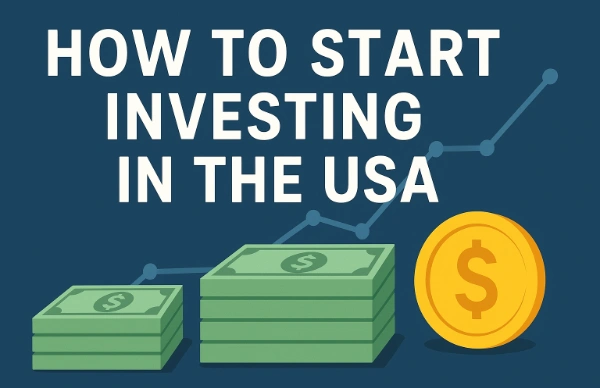Introduction to Investing
Starting your investment journey in the USA can feel overwhelming, but it doesn’t have to be. Whether you’re a college graduate with your first job or someone who’s been putting off investing for years, this comprehensive guide will walk you through everything you need to know about how to start investing in the USA as a complete beginner.
Investing is one of the most powerful tools for building wealth over time. With the right knowledge and approach, anyone can learn to invest successfully and secure their financial future. This step-by-step guide for beginners will demystify the investment process and give you the confidence to take your first steps toward financial independence.
The American financial markets offer incredible opportunities for individual investors. From the New York Stock Exchange to NASDAQ, from mutual funds to ETFs, the options might seem endless. But don’t worry – we’ll break everything down into manageable, actionable steps that any beginner can follow.
Table of Contents
Why Start Investing Today?
The Power of Compound Interest
Albert Einstein allegedly called compound interest “the eighth wonder of the world.” When you start investing in the USA, you’re harnessing this powerful force. Compound interest means earning returns not just on your initial investment, but also on the returns you’ve already earned.
Consider this example: If you invest $1,000 at an average annual return of 7%, after 30 years, you’d have approximately $7,612. That’s $6,612 in growth from just a $1,000 initial investment. This demonstrates why investing for beginners should start as early as possible.
Beating Inflation
Inflation erodes the purchasing power of your money over time. In 2023, the average inflation rate in the USA was around 3.2%. If your money sits in a savings account earning 0.5% interest, you’re actually losing purchasing power. Investment strategies for beginners must account for inflation to preserve and grow wealth.
Building Financial Security
Regular investing helps create multiple income streams and builds a safety net for unexpected expenses, career changes, or retirement. When you learn how to invest money systematically, you’re essentially paying your future self.
Table Suggestion 1: Inflation Impact on $10,000 Over Time
| Years | Value at 3% Inflation | Real Purchasing Power |
|---|---|---|
| 5 | $11,593 | $8,626 |
| 10 | $13,439 | $7,441 |
| 20 | $18,061 | $5,537 |
| 30 | $24,273 | $4,120 |
Understanding Your Financial Foundation
Emergency Fund First
Before you start investing in stocks or any other securities, establish a solid financial foundation. Financial experts recommend having 3-6 months of living expenses in a high-yield savings account as an emergency fund.
This emergency fund serves as your financial safety net, ensuring you won’t need to sell investments at an inopportune time to cover unexpected expenses. Calculate your monthly expenses including rent, utilities, food, transportation, and insurance to determine your emergency fund target.
Debt Assessment
High-interest debt, particularly credit card debt, should typically be paid off before investing. If you’re carrying credit card debt with interest rates of 18-25%, paying off this debt guarantees that return rate – something even the best investment options for beginners can’t promise.
However, low-interest debt like student loans or mortgages with rates below 5-6% might be worth carrying while you invest, especially if you can earn higher returns in the market.
Setting Investment Goals
Clear goals are essential for successful investing for beginners in the USA. Your investment strategy will differ significantly depending on whether you’re investing for:
- Retirement (20-40 years away)
- A house down payment (2-5 years)
- Children’s education (10-18 years)
- General wealth building
Determining Your Risk Tolerance
Risk tolerance involves both your emotional capacity to handle market volatility and your financial ability to absorb potential losses. Young investors typically can afford to take more risks because they have decades to recover from market downturns.
Table Suggestion 2: Risk Tolerance Assessment
| Factor | Conservative | Moderate | Aggressive |
|---|---|---|---|
| Age | 50+ | 30-50 | Under 30 |
| Time Horizon | Under 5 years | 5-15 years | 15+ years |
| Market Drop Comfort | 5-10% | 10-20% | 20%+ |
| Income Stability | Fixed/Uncertain | Stable | Very Stable |
Types of Investment Accounts
Individual Taxable Accounts
Regular brokerage accounts offer maximum flexibility for how to start investing in stocks and other securities. You can deposit and withdraw money at any time, but you’ll pay taxes on dividends, interest, and capital gains.
These accounts are ideal for:
- Short to medium-term goals
- After maxing out retirement accounts
- When you need investment flexibility
Traditional IRA
A Traditional Individual Retirement Account allows you to deduct contributions from your current year’s taxes, reducing your taxable income. The money grows tax-deferred until retirement, when withdrawals are taxed as ordinary income.
For 2024, you can contribute up to $7,000 annually ($8,000 if you’re 50 or older). This makes Traditional IRAs excellent investment accounts for beginners who want immediate tax benefits.
Roth IRA
With a Roth IRA, you contribute after-tax dollars, but qualified withdrawals in retirement are completely tax-free. This is particularly valuable for young investors who expect to be in a higher tax bracket in retirement.
The same contribution limits apply, but Roth IRAs have income limits. In 2024, you can contribute the full amount if your modified adjusted gross income is under $138,000 (single) or $218,000 (married filing jointly).
401(k) and Employer Plans
If your employer offers a 401(k) plan, especially with matching contributions, this should be your first priority. Employer matching is essentially free money – a guaranteed 100% return on your investment up to the match limit.
For 2024, you can contribute up to $23,000 to a 401(k), with an additional $7,500 catch-up contribution if you’re 50 or older.
Popular Investment Options for Beginners
Exchange-Traded Funds (ETFs)
ETFs are among the best investment options for beginners because they offer instant diversification at low costs. These funds track an index, commodity, bonds, or basket of assets like a mutual fund but trade like individual stocks.
Popular beginner-friendly ETFs include:
- Total Stock Market ETFs: Provide exposure to the entire US stock market
- S&P 500 ETFs: Track the 500 largest US companies
- International ETFs: Offer global diversification
- Bond ETFs: Provide stability and income
Index Funds
Index funds are mutual funds designed to track a specific market index. They’re perfect for beginner investment strategies because they require minimal research and offer broad market exposure at low costs.
The most famous example is funds that track the S&P 500, which has historically returned about 10% annually over long periods. Index funds eliminate the need to pick individual stocks while providing professional management.
Individual Stocks
While riskier than diversified funds, investing in individual stocks can be rewarding for beginners willing to do research. Start with large, established companies (blue-chip stocks) that you understand and use regularly.
Consider companies like:
- Apple (AAPL)
- Microsoft (MSFT)
- Johnson & Johnson (JNJ)
- Coca-Cola (KO)
Target-Date Funds
Target-date funds automatically adjust their asset allocation as you approach your target retirement date. They start aggressive (more stocks) when you’re young and become conservative (more bonds) as you near retirement.
These funds are excellent for retirement investing for beginners because they require zero maintenance and provide professional asset allocation.
Bonds and Bond Funds
Bonds are loans you make to corporations or governments in exchange for regular interest payments. They’re generally less volatile than stocks and provide steady income, making them important for portfolio balance.
Table Suggestion 3: Investment Types Comparison
| Investment Type | Risk Level | Expected Return | Liquidity | Best For |
|---|---|---|---|---|
| ETFs | Low-High | 6-10% | High | Diversification |
| Index Funds | Low-Medium | 7-10% | Medium | Long-term growth |
| Individual Stocks | High | Variable | High | Active investors |
| Bonds | Low | 3-5% | Medium | Stability |
| Target-Date Funds | Medium | 6-8% | Medium | Set-and-forget |
How to Choose the Right Brokerage

Commission-Free Trading
Most major brokerages now offer commission-free stock and ETF trading, making it easier than ever to start investing with little money. Focus on brokerages that don’t charge fees for basic transactions.
Account Minimums
Many brokerages have eliminated account minimums, allowing you to start investing with as little as $1. This democratization of investing means anyone can begin their investment journey for beginners regardless of their starting capital.
Research Tools and Education
Look for brokerages that provide robust research tools, educational resources, and market analysis. Features to consider include:
- Real-time quotes and charts
- Company financial data
- Analyst ratings and reports
- Educational webinars and articles
Popular Brokerage Options
Fidelity: Known for excellent research tools and no account minimums. Offers fractional shares and extensive educational resources.
Charles Schwab: Provides comprehensive investment services with excellent customer support and competitive pricing.
Vanguard: Famous for low-cost index funds and ETFs, ideal for long-term investors following passive investment strategies.
E*TRADE: Offers user-friendly platforms and good tools for both beginners and active traders.
Robinhood: Simple mobile-first platform that made commission-free trading mainstream, perfect for investing apps for beginners.
Account Opening Process
Opening a brokerage account typically involves:
- Providing personal information (Social Security number, address, employment)
- Answering questions about investment experience and risk tolerance
- Funding your account via bank transfer, check, or wire
- Waiting 1-3 business days for funds to settle before trading
Step-by-Step Investment Process
Step 1: Set Your Investment Goals
Define what you’re investing for and when you’ll need the money. This determines your investment timeline and risk tolerance. Retirement planning for beginners requires a different approach than saving for a house down payment.
Write down specific, measurable goals:
- “I want to accumulate $500,000 for retirement by age 65”
- “I need $50,000 for a house down payment in 5 years”
- “I want to build a $100,000 emergency fund over 10 years”
Step 2: Determine Your Asset Allocation
Asset allocation is how you divide your investments among different asset classes (stocks, bonds, real estate, etc.). A common rule of thumb is to subtract your age from 100 to determine your stock allocation percentage.
For example, a 25-year-old might have:
- 75% stocks (100 – 25 = 75)
- 25% bonds and other conservative investments
Step 3: Choose Your Investments
Based on your research and goals, select specific investments. For beginners, starting with broad market index funds or ETFs is often the wisest choice for how to build wealth through investing.
Step 4: Make Your First Purchase
Log into your brokerage account, search for your chosen investment, and place your order. You can typically choose between:
- Market orders: Buy/sell immediately at current market price
- Limit orders: Buy/sell only at a specific price or better
Step 5: Set Up Automatic Investing
Dollar-cost averaging involves investing a fixed amount regularly regardless of market conditions. This strategy reduces the impact of market volatility and helps build consistent investing habits.
Most brokerages allow you to set up automatic investments weekly, bi-weekly, or monthly. This approach is perfect for investment strategies for beginners because it removes emotion from investment decisions.
Building Your First Portfolio
The Three-Fund Portfolio
Many financial experts recommend starting with a simple three-fund portfolio:
- Total Stock Market Index Fund (70%): Provides exposure to the entire US stock market
- International Stock Index Fund (20%): Offers global diversification
- Bond Index Fund (10%): Adds stability and reduces volatility
This simple allocation covers thousands of stocks and bonds while keeping costs low and management simple.
Sample Beginner Portfolios
Conservative Portfolio (Age 50+):
- 40% US Total Stock Market
- 20% International Stocks
- 30% Bonds
- 10% REITs
Moderate Portfolio (Age 30-50):
- 60% US Total Stock Market
- 20% International Stocks
- 15% Bonds
- 5% REITs
Aggressive Portfolio (Age 20-30):
- 70% US Total Stock Market
- 25% International Stocks
- 5% Bonds
Rebalancing Your Portfolio
Over time, different investments will grow at different rates, causing your portfolio to drift from its target allocation. Rebalancing involves selling overweighted assets and buying underweighted ones to return to your target allocation.
Plan to rebalance:
- Annually
- When any asset class deviates more than 5% from its target
- During major life changes
Table Suggestion 4: Sample Portfolio Allocations by Age
| Age Group | US Stocks | International Stocks | Bonds | REITs | Cash |
|---|---|---|---|---|---|
| 20-30 | 60% | 25% | 10% | 5% | 0% |
| 30-40 | 55% | 25% | 15% | 5% | 0% |
| 40-50 | 50% | 20% | 25% | 5% | 0% |
| 50-60 | 40% | 20% | 35% | 5% | 0% |
| 60+ | 30% | 15% | 45% | 5% | 5% |
Risk Management Strategies
Diversification: Don’t Put All Eggs in One Basket
Diversification is the practice of spreading investments across different asset classes, industries, and geographic regions. This investment strategy for beginners helps reduce portfolio risk without necessarily reducing returns.
Types of diversification include:
- Asset class diversification: Stocks, bonds, real estate, commodities
- Geographic diversification: US and international markets
- Sector diversification: Technology, healthcare, finance, consumer goods
- Company size diversification: Large-cap, mid-cap, and small-cap stocks
Understanding Market Volatility
Stock market volatility is normal and expected. The S&P 500 experiences corrections (drops of 10% or more) about once every 1-2 years and bear markets (drops of 20% or more) roughly every 5-7 years.
Historical market data shows that despite short-term volatility, patient long-term investors have been rewarded. The key is having the right mindset and not panicking during downturns.
Risk vs. Return Relationship
Generally, investments with higher potential returns come with higher risks. Understanding this relationship helps you make informed decisions about how to invest money wisely.
- Low Risk, Low Return: Savings accounts, CDs, government bonds
- Medium Risk, Medium Return: Balanced mutual funds, dividend stocks
- High Risk, High Return: Individual growth stocks, cryptocurrency, options
Dollar-Cost Averaging
Dollar-cost averaging is a strategy where you invest a fixed amount regularly, regardless of market conditions. This approach helps smooth out market volatility and can reduce the average cost of your investments over time.
For example, investing $500 monthly in an S&P 500 index fund means you’ll buy more shares when prices are low and fewer when prices are high, potentially improving your average purchase price.
Common Beginner Mistakes to Avoid
Trying to Time the Market
One of the biggest mistakes in investing for beginners is attempting to time the market – trying to buy at the bottom and sell at the top. Even professional investors struggle with market timing, and research shows that time in the market beats timing the market.
Instead of waiting for the “perfect” time to invest, start as soon as you have your emergency fund and have eliminated high-interest debt.
Lack of Diversification
Putting all your money into one stock, sector, or investment type exposes you to unnecessary risk. Many beginners make the mistake of investing heavily in their employer’s stock or a few popular companies they’ve heard about.
Emotional Investing
Fear and greed are investors’ worst enemies. During market downturns, fear drives people to sell at exactly the wrong time. During bull markets, greed leads to risky investments and overconfidence.
Successful long-term investing strategies require emotional discipline and sticking to your plan regardless of short-term market movements.
Chasing Performance
Past performance doesn’t guarantee future results. Many beginners make the mistake of investing in last year’s best-performing funds or stocks, only to be disappointed when that performance doesn’t continue.
Not Starting Early Enough
Perhaps the biggest mistake is not starting at all. Thanks to compound interest, even small amounts invested early can grow significantly over time. Don’t wait until you have a large sum to invest – start with whatever you can afford.
Ignoring Fees
High fees can significantly erode investment returns over time. A fund with a 1.5% expense ratio will cost you significantly more than one with a 0.1% expense ratio over decades of investing.
Table Suggestion 5: Impact of Fees on $10,000 Investment Over 30 Years
| Annual Fee | Final Value | Total Fees Paid |
|---|---|---|
| 0.1% | $72,890 | $2,110 |
| 0.5% | $66,231 | $8,769 |
| 1.0% | $59,783 | $15,217 |
| 1.5% | $53,816 | $21,184 |
Tax Considerations for Investors {#tax-considerations}
Understanding Capital Gains Tax
When you sell investments for more than you paid, you realize capital gains, which are subject to tax. The tax rate depends on how long you held the investment:
- Short-term capital gains (held less than one year): Taxed as ordinary income
- Long-term capital gains (held more than one year): Taxed at preferential rates of 0%, 15%, or 20%
This tax structure encourages long-term investing, which aligns with proven wealth building strategies.
Tax-Loss Harvesting
Tax-loss harvesting involves selling losing investments to offset gains from winning investments, reducing your overall tax bill. However, be aware of the wash-sale rule, which prevents you from claiming a loss if you buy the same or substantially identical security within 30 days.
Qualified Dividends
Most dividends from US companies qualify for the same preferential tax rates as long-term capital gains. This makes dividend-paying stocks and funds tax-efficient choices for taxable accounts.
Tax-Advantaged Account Strategies
Maximize tax-advantaged accounts before investing in taxable accounts:
- Contribute enough to 401(k) to get full employer match
- Max out Roth IRA contribution
- Return to 401(k) to maximize contribution
- Consider taxable account investing
Long-term Investment Strategies

Buy and Hold Strategy
The buy and hold strategy involves purchasing quality investments and holding them for years or decades, regardless of short-term market fluctuations. This approach aligns with proven investment principles for beginners and has historically rewarded patient investors.
Warren Buffett, one of the world’s most successful investors, advocates for this approach: “Time is the friend of the wonderful business, the enemy of the mediocre.”
Value Investing
Value investing involves buying stocks that appear underpriced by fundamental analysis. This strategy requires more research and patience but can be rewarding for dedicated investors willing to learn stock market basics.
Key value investing principles:
- Buy stocks trading below their intrinsic value
- Focus on companies with strong fundamentals
- Be patient – value recognition can take years
- Maintain a margin of safety
Growth Investing
Growth investing focuses on companies expected to grow earnings faster than the market average. These companies typically reinvest profits rather than paying dividends, leading to higher stock price appreciation potential.
Growth investing characteristics:
- Higher price-to-earnings ratios
- Focus on future potential rather than current value
- More volatile than value stocks
- Popular in technology and healthcare sectors
Index Investing
Index investing, also called passive investing, involves buying funds that track market indices rather than trying to beat the market. This strategy has gained popularity due to its simplicity and consistent performance.
Benefits of index investing:
- Low fees and expenses
- Broad market diversification
- No need for active management
- Historically outperforms most active funds
Monitoring and Rebalancing Your Portfolio
How Often to Check Your Investments
While it’s natural to want to check your investments frequently, especially when starting out, daily monitoring can lead to emotional decision-making. Financial planning for beginners should emphasize patience and long-term thinking.
Recommended monitoring frequency:
- Monthly: Quick portfolio review
- Quarterly: Detailed analysis and minor adjustments
- Annually: Comprehensive review and rebalancing
Key Metrics to Track
Focus on these important metrics when monitoring your investments:
- Total portfolio value: Overall growth trajectory
- Asset allocation: Ensure it matches your target
- Expense ratios: Keep investment costs low
- Performance vs. benchmarks: Compare to relevant market indices
When to Rebalance
Rebalancing maintains your target asset allocation as different investments grow at different rates. Signs it’s time to rebalance:
- Any asset class deviates more than 5% from target allocation
- Annual review regardless of allocation drift
- Major life changes affecting risk tolerance
- Significant market movements
Rebalancing Methods
Threshold rebalancing: Rebalance when allocations drift beyond predetermined thresholds (e.g., 5%).
Calendar rebalancing: Rebalance on a fixed schedule (annually or semi-annually).
Combination approach: Use calendar rebalancing with threshold monitoring for significant drifts.
Advanced Topics for Growing Investors
Dollar-Cost Averaging vs. Lump Sum Investing
Dollar-cost averaging involves investing fixed amounts regularly, while lump sum investing means investing all available money immediately. Research shows lump sum investing often performs better mathematically, but dollar-cost averaging provides psychological benefits and risk reduction.
International Diversification
US stocks represent about 60% of global market capitalization, meaning international investing provides access to the remaining 40%. International diversification can reduce portfolio risk and provide exposure to different economic cycles.
Consider allocating 20-40% of your stock allocation to international markets through:
- Developed market funds (Europe, Japan, Australia)
- Emerging market funds (China, India, Brazil)
- Global funds combining both
Real Estate Investment Trusts (REITs)
REITs allow you to invest in real estate without directly owning property. They’re required to distribute at least 90% of taxable income as dividends, making them attractive for income-focused investors.
REITs provide:
- Exposure to real estate markets
- Regular dividend income
- Inflation protection potential
- Portfolio diversification
Sector Rotation Strategies
As the economy moves through different cycles, various sectors perform differently. Understanding sector rotation can help optimize portfolio performance, though it requires more active management than passive indexing.
Economic cycle sectors:
- Early cycle: Technology, consumer discretionary
- Mid cycle: Industrials, materials
- Late cycle: Energy, utilities
- Recession: Consumer staples, healthcare
Table Suggestion 6: Investment Timeline and Strategy
| Time Horizon | Primary Goal | Recommended Strategy | Risk Level |
|---|---|---|---|
| 0-2 years | Capital preservation | High-yield savings, CDs | Very Low |
| 2-5 years | Modest growth | Conservative balanced funds | Low |
| 5-10 years | Moderate growth | Balanced stock/bond portfolio | Medium |
| 10-20 years | Growth with some income | Growth-focused diversified portfolio | Medium-High |
| 20+ years | Maximum growth | Aggressive growth portfolio | High |
Building Wealth Through Consistent Investing
The Magic of Starting Early
The earlier you start investing, the more time your money has to compound. Consider two investors:
Sarah starts investing $200 monthly at age 25 and stops at 35 (10 years, $24,000 invested). John starts investing $200 monthly at age 35 and continues until 65 (30 years, $72,000 invested).
Assuming 7% annual returns, at age 65:
- Sarah’s portfolio: ~$169,000
- John’s portfolio: ~$244,000
Despite investing three times more money, John’s later start meant significantly less wealth accumulation, demonstrating why early investing strategies are crucial.
Increasing Investment Contributions
As your income grows, increase your investment contributions. A good strategy is to invest at least 50% of any raise or bonus. This allows you to maintain your current lifestyle while accelerating wealth building.
The 15% Rule
Financial experts often recommend investing 15% of gross income for retirement. This includes employer 401(k) matches. Start with whatever you can afford and gradually increase toward this target.
Emergency Fund Integration
Maintain your emergency fund even while investing. Some investors keep a smaller emergency fund (3 months expenses) and invest the rest, knowing they could access taxable investment accounts if needed.
Technology and Investment Tools
Robo-Advisors
Robo-advisors provide automated investment management using algorithms to create and maintain portfolios. They’re excellent for passive investing for beginners who want professional management without high fees.
Popular robo-advisors include:
- Betterment: Goal-based investing with tax-loss harvesting
- Wealthfront: Advanced tax optimization features
- Vanguard Personal Advisor Services: Combines robo-investing with human advisors
Investment Apps
Modern investing apps for beginners have made investing more accessible and engaging:
- Acorns: Rounds up purchases and invests spare change
- Stash: Offers fractional shares and educational content
- M1 Finance: Provides “pie” investing for easy portfolio management
Financial Planning Software
Tools like Personal Capital (now Empower) help track net worth, analyze fees, and plan for retirement. These platforms aggregate all your accounts for a comprehensive financial overview.
Understanding Market Cycles and Economic Indicators
Market Cycles
Understanding market cycles helps maintain perspective during volatile periods. Typical cycle phases include:
Bull Market: Rising prices, investor optimism, economic growth Bear Market: Falling prices (20%+ decline), pessimism, economic contraction Correction: Temporary decline of 10-20% Recovery: Market begins rising from lows
Economic Indicators
Key indicators that influence investment markets:
- GDP Growth: Measures overall economic health
- Unemployment Rate: Indicates job market strength
- Inflation Rate: Affects purchasing power and interest rates
- Interest Rates: Impact bond prices and borrowing costs
Federal Reserve Policy
The Federal Reserve’s decisions on interest rates significantly impact investment markets. Lower rates generally favor stocks, while higher rates can benefit bonds and savings accounts.
Retirement Investing Specifics
401(k) Optimization
Maximize your 401(k) effectiveness:
- Contribute enough to get full employer match
- Choose low-cost index funds when available
- Increase contributions with salary raises
- Consider Roth 401(k) if offered
IRA vs. 401(k) Decision Making
When you have both options available:
- Prioritize 401(k) up to employer match
- Consider IRA for better investment options
- Return to 401(k) for higher contribution limits
- Factor in current vs. future tax rates
Retirement Income Planning
As retirement approaches, shift focus from accumulation to income generation:
- Increase bond allocation
- Consider dividend-paying stocks
- Plan withdrawal strategies
- Understand required minimum distributions (RMDs)
Table Suggestion 7: Retirement Account Comparison
| Account Type | 2024 Limit | Tax Treatment | Withdrawal Rules | Best For |
|---|---|---|---|---|
| Traditional 401(k) | $23,000 | Tax-deferred | RMDs at 73 | Current tax deduction |
| Roth 401(k) | $23,000 | Tax-free growth | RMDs at 73 | Tax-free retirement |
| Traditional IRA | $7,000 | Tax-deferred | RMDs at 73 | No employer plan |
| Roth IRA | $7,000 | Tax-free growth | No RMDs | Tax-free flexibility |
Investment Psychology and Behavioral Finance
Overcoming Investment Biases
Human psychology can work against successful investing. Common biases include:
Confirmation Bias: Seeking information that confirms existing beliefs Loss Aversion: Feeling losses more acutely than equivalent gains Herding: Following crowd behavior instead of independent analysis Overconfidence: Believing you can predict market movements
Building Investment Discipline
Successful investing habits for beginners include:
- Automating investments to remove emotion
- Focusing on long-term goals during volatility
- Regularly educating yourself about investing
- Avoiding financial media during stressful periods
The Importance of Patience
Wealth building through investing requires patience and persistence. Short-term market movements are essentially random, but long-term trends favor patient investors who stay the course.
Historical data shows that holding periods of 15+ years have never resulted in losses for diversified US stock portfolios, emphasizing the importance of long-term thinking.
ESG and Sustainable Investing
Environmental, Social, and Governance (ESG) Investing
ESG investing considers environmental, social, and governance factors alongside financial returns. This approach has gained popularity among younger investors who want their investments to align with their values.
ESG considerations include:
- Environmental: Climate change, pollution, resource conservation
- Social: Employee treatment, community impact, product safety
- Governance: Board diversity, executive compensation, shareholder rights
Impact Investing
Impact investing specifically targets investments that generate positive social or environmental impact alongside financial returns. Options include green bonds, community development funds, and social impact bonds.
Performance of ESG Investments
Research suggests that ESG investments can perform competitively with traditional investments while providing additional non-financial benefits. Many major index fund companies now offer ESG versions of popular funds.
Alternative Investment Options
Real Estate Investment Trusts (REITs)
REITs provide real estate exposure without property ownership hassles. They offer:
- Regular dividend income
- Inflation protection potential
- Professional property management
- Liquidity unlike direct real estate ownership
Commodity Investing
Commodities like gold, oil, and agricultural products can provide portfolio diversification and inflation protection. However, they don’t produce income and can be highly volatile.
Cryptocurrency Considerations
While not traditional investments, cryptocurrencies have gained mainstream attention. If considering crypto:
- Limit to small portfolio percentage (5% or less)
- Understand the extreme volatility
- Research thoroughly before investing
- Consider it speculative rather than core portfolio component
Building Your Investment Knowledge
Recommended Reading
Essential books for investment education for beginners:
- “The Bogleheads’ Guide to Investing” by Taylor Larimore
- “A Random Walk Down Wall Street” by Burton Malkiel
- “The Little Book of Common Sense Investing” by John Bogle
- “Your Money or Your Life” by Vicki Robin
Online Resources
Valuable websites for continuing education:
- SEC’s Investor.gov for unbiased investment education
- Morningstar for investment research and analysis
- Bogleheads.org community forum for index investing
- Company annual reports for fundamental analysis
Professional Help
Consider professional help when:
- Your portfolio exceeds $100,000-$500,000
- You have complex tax situations
- You’re approaching retirement
- You lack time for investment management
Types of financial professionals:
- Fee-only financial planners: Paid by clients only
- Robo-advisors: Automated portfolio management
- Full-service brokers: Comprehensive financial services
Frequently Asked Questions
How much money do I need to start investing in the USA?
You can start investing with as little as $1 thanks to fractional shares offered by most modern brokerages. However, having $500-$1,000 provides more flexibility and reduces the impact of any fees. The key is to start with whatever amount you can consistently invest without affecting your essential expenses or emergency fund.
What’s the difference between stocks and bonds?
Stocks represent ownership shares in companies, offering higher growth potential but more risk. When you buy stock, you become a partial owner and benefit from company success through price appreciation and dividends. Bonds are loans to companies or governments that pay fixed interest over time, providing more stability but lower returns. A balanced portfolio typically includes both for optimal risk-adjusted returns.
Should I invest in individual stocks or funds?
For beginners, funds (mutual funds or ETFs) are generally recommended because they provide instant diversification across hundreds or thousands of stocks. Individual stock investing requires significant research and carries higher risk since you’re betting on specific companies. Once you gain experience and knowledge, you might allocate a small portion (5-10%) to individual stocks you’ve thoroughly researched.
How do I know if I’m ready to start investing?
You’re ready to start investing when you have:
An emergency fund covering 3-6 months of expenses
High-interest debt (credit cards) paid off
Stable income source
Basic understanding of investment principles
Clear investment goals and timeline Even if you don’t check every box perfectly, starting small while building your foundation is better than waiting indefinitely.
What’s the best investment strategy for beginners?
The best strategy for most beginners is a simple, diversified approach using low-cost index funds or ETFs. Start with a three-fund portfolio (total stock market, international stocks, bonds) and automate regular contributions. This approach provides broad market exposure, low costs, and eliminates the need for complex decision-making while you learn.
Conclusion
Starting your investment journey in the USA is one of the most important financial decisions you can make. This comprehensive step-by-step guide for beginners has covered everything from opening your first brokerage account to building a diversified portfolio that can grow your wealth over decades.
Remember these key principles as you begin investing for beginners in the USA:
Start Early: Time is your greatest asset when investing. Even small amounts invested young can grow into substantial wealth through compound interest.
Stay Consistent: Regular investing through dollar-cost averaging helps build wealth and reduces the impact of market volatility.
Keep It Simple: You don’t need complex strategies to succeed. Low-cost index funds provide excellent diversification and historically strong returns.
Stay Disciplined: Market volatility is normal. Stick to your investment plan rather than making emotional decisions during market ups and downs.
Continue Learning: Investment knowledge compounds like investment returns. Keep reading, learning, and refining your approach as you gain experience.
Focus on What You Can Control: You can’t control market movements, but you can control your savings rate, investment costs, asset allocation, and investment timeline.
The journey of how to start investing in the USA begins with a single step. Whether you start with $50 or $5,000, the important thing is to start. Your future self will thank you for taking action today rather than waiting for tomorrow.
Remember that successful investing isn’t about getting rich quick – it’s about building wealth steadily over time through patient, disciplined investing. The investment strategies for beginners outlined in this guide have helped millions of Americans build financial security and achieve their long-term goals.
Take action today. Open that brokerage account, make your first investment, and begin your journey toward financial independence. The best time to start investing was yesterday; the second-best time is today.
Investment success comes not from perfect timing or superior stock picking, but from starting early, staying consistent, and letting compound interest work its magic over decades of patient investing.
Disclaimer: The information provided on CryptoStockHub.com is for educational and informational purposes only and should not be considered financial, investment, or trading advice. We are not financial advisors. Investing in stocks, ASX shares, blockchain, or cryptocurrencies is a high-risk endeavor, and it is essential to conduct your own research or consult a licensed financial advisor before making any investment decisions. Past performance is not an indication of future results.






